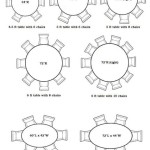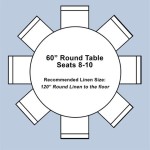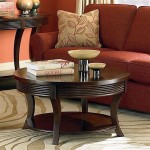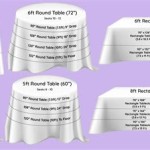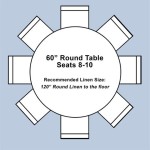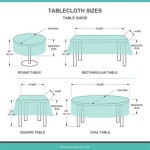What Size Area Rug For Round Dining Table: A Comprehensive Guide
Selecting the appropriate area rug for a round dining table involves considering several factors to achieve a balanced and aesthetically pleasing dining space. The rug serves not only as a decorative element but also as a functional component, defining the dining area, providing comfort underfoot, and protecting the flooring beneath.
The primary consideration when choosing a rug size is ensuring that all chair legs remain on the rug even when the chairs are pulled out from the table. This prevents chairs from wobbling and ensures a comfortable dining experience. Furthermore, a properly sized rug anchors the dining set, contributing to a cohesive and visually appealing room design. Failure to select the correct size can result in a rug that looks disproportionate or, worse, impedes the functionality and comfort of the dining area.
This article will explore the key factors in determining the optimal rug size for a round dining table, providing guidelines and practical tips to assist in making an informed decision. The discussion will encompass considerations such as dining table diameter, room size, furniture arrangement, and personal aesthetic preferences.
Understanding Overhang and Clearance
The concept of overhang and clearance is crucial when determining the ideal rug size. Overhang refers to the amount the rug extends beyond the edge of the table, while clearance refers to the amount of space available for chair movement while remaining entirely on the rug. A general guideline suggests an overhang of at least 24 to 36 inches around the perimeter of the round dining table. This measurement ensures that when a chair is pulled out for someone to sit, all four legs remain on the rug, preventing instability and potential floor damage.
To accurately calculate the necessary rug size, measure the diameter of the round dining table. Add 48 to 72 inches (24 to 36 inches on each side) to this measurement. For example, if the round dining table has a diameter of 48 inches, the minimum rug diameter should be between 96 and 120 inches (8 to 10 feet). This calculation provides a rough estimate; however, specific circumstances may require adjustments.
Consider the placement of other furniture within the dining area. If the dining area is part of an open-concept space, the rug should be large enough to visually define the dining zone and separate it from adjacent areas, such as the living room or kitchen. In smaller dining rooms, adhering strictly to the 24-36 inch overhang rule may not be feasible; in such cases, prioritize ensuring all chair legs stay on the rug when the chairs are in use, even if the overhang is slightly less.
The rug's thickness also influences the chair movement. A thicker rug might make it harder to pull chairs in and out smoothly, especially if the chair legs aren't equipped with glides or casters. Selecting a rug with an appropriate pile height can mitigate this issue, ensuring ease of use and preventing potential damage to both the rug and the floor.
Factors Affecting Rug Size Selection
While the basic overhang rule provides a solid foundation, several other factors can influence the final rug size decision. These include the room's dimensions, the presence of other furniture, the style of the dining table and chairs, and the desired aesthetic effect.
Room Size: In larger dining rooms, a smaller rug under a round table can appear disproportionate and visually isolated. In such spaces, consider opting for a larger rug that extends further into the room, helping to ground the dining set and create a more cohesive feel. Conversely, in smaller dining rooms, an excessively large rug can overwhelm the space and make it feel cramped. It is crucial to maintain a balance between the rug size and the room's overall dimensions.
Furniture Arrangement: The presence of other furniture pieces within the dining area, such as sideboards, buffets, or display cabinets, can affect the optimal rug size. Ensure that the rug does not extend underneath these furniture pieces, as this can create a cluttered and visually disjointed appearance. The rug should primarily define the dining space centered around the table and chairs, without encroaching on the areas occupied by other larger furniture items.
Table and Chair Style: The style of the dining table and chairs can also influence the visual impact of the rug. For example, a modern, minimalist dining set might benefit from a rug with a clean, geometric pattern, while a more traditional dining set might pair well with a rug featuring a richer, more ornate design. Similarly, the height of the chair legs can affect the perceived size of the rug; taller chairs may require a slightly larger rug to maintain visual balance. A table with a pedestal base may also allow some flexibility in rug size compared to a table with four legs.
Aesthetic Preferences: Ultimately, personal taste plays a significant role in rug selection. While following the general guidelines is advisable, individuals may choose to deviate from the norm to achieve a specific aesthetic effect. For example, some may prefer a slightly smaller rug to create a more open and airy feel, while others may opt for a larger rug to add warmth and coziness to the dining space. It is crucial to consider the overall design scheme and personal preferences when making the final rug size decision.
Beyond the size, considering the shape of the rug underneath a round dining table is also crucial. While a round rug is the most intuitive choice, square or even octagonal area rugs can also be used to create a unique aesthetic. When using a shape other than round, ensure the rug is large enough to accommodate the chairs when pulled out, and that the corners or edges do not create awkward traffic flow areas. The goal is to enhance the dining experience, not hinder it.
Practical Tips for Measuring and Selecting a Rug
Accurate measurement is essential for selecting the correct rug size. Follow these practical tips to ensure precise measurements and a well-informed decision.
Measure the Table Diameter: Use a measuring tape to determine the diameter of the round dining table. Measure from one edge of the table, passing through the center, to the opposite edge. Repeat the measurement at a different angle to ensure accuracy. Record the measurement in inches.
Simulate Chair Placement: Use painter's tape to mark the area occupied by the chairs when they are pulled out from the table. Position the chairs as if someone were sitting in them, and use the tape to outline the space each chair occupies. This will provide a visual representation of the required rug size to accommodate the chairs properly.
Consider Room Dimensions: Measure the length and width of the dining room. Use these measurements to determine the available space for the rug. Ensure that the rug does not extend too close to the walls, leaving a border of exposed flooring around the perimeter of the room. This border helps to prevent the rug from overwhelming the space and creates a more balanced appearance.
Test with Temporary Rug Alternatives: Before purchasing a rug, consider using temporary alternatives to test the desired size and placement. For example, use sheets or towels to simulate the size and shape of the potential rug. This allows individuals to visualize the rug in the dining area and assess its impact on the overall design before making a financial commitment.
Seek Professional Advice: If unsure about rug selection, consult with an interior designer or a rug specialist. These professionals can provide expert guidance based on individual needs and preferences, helping navigate the various factors involved in rug size selection. They can offer personalized recommendations and assist in finding a rug that complements the dining set and enhances the overall aesthetic of the space.
Remember to account for rug shrinkage and stretching. Natural fibers, such as wool, can sometimes shrink or stretch slightly after cleaning or due to changes in humidity. It’s therefore wise to select a rug size that allows for a small margin of error. Also, consider the rug’s care instructions before purchasing. Some rugs require professional cleaning, while others can be cleaned at home.
By carefully considering these factors and following these practical tips, individuals can confidently select the appropriate rug size for a round dining table, creating a functional, visually appealing, and comfortable dining space. The right rug not only enhances the aesthetic appeal of the room but also protects the flooring and provides a comfortable surface underfoot, contributing to a pleasant dining experience for family and guests alike.

Rules Of Thumb For Rugs Under Round Dining Tables Inspiration

Rules Of Thumb For Rugs Under Round Dining Tables Inspiration

Rules Of Thumb For Rugs Under Round Dining Tables Inspiration

6 Rules For Choosing A Dining Room Rug Pretty Souces Stonegable

Rules Of Thumb For Rugs Under Round Dining Tables Inspiration

Round Rug Size Guide For 36 42 48 54 60 72 Inch Tables Rugs Direct

Round Rug Size Guide For 36 42 48 54 60 72 Inch Tables Rugs Direct

Simple Rules For Dining Room Rugs Floorspace

Best Dining Room Rugs 2024

6 Rules For Choosing A Dining Room Rug Pretty Souces Stonegable
Related Posts

